COUNTER TERRORISM.
VerifiedAdded on 2022/11/28
|12
|4339
|2
AI Summary
Contribute Materials
Your contribution can guide someone’s learning journey. Share your
documents today.
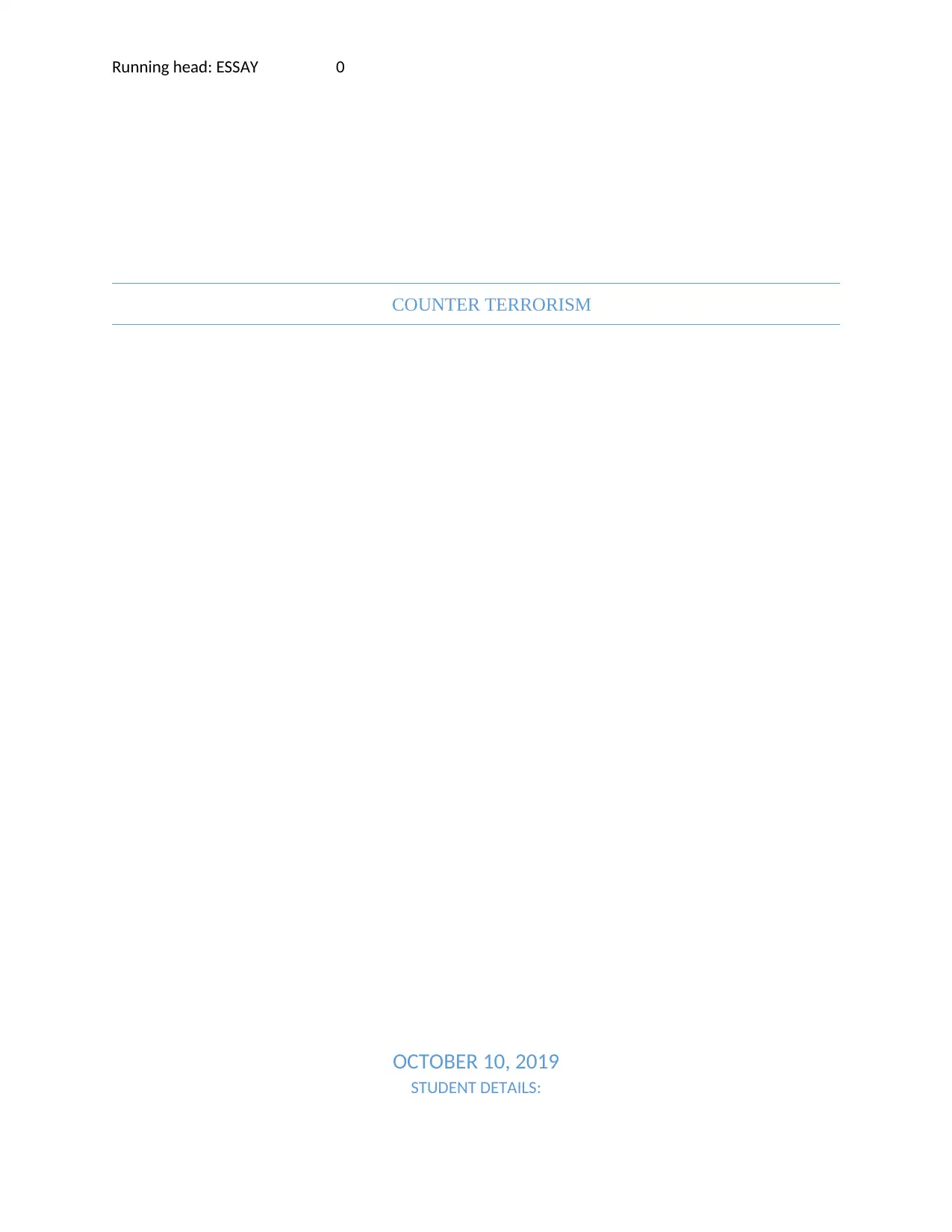
Running head: ESSAY 0
COUNTER TERRORISM
OCTOBER 10, 2019
STUDENT DETAILS:
COUNTER TERRORISM
OCTOBER 10, 2019
STUDENT DETAILS:
Secure Best Marks with AI Grader
Need help grading? Try our AI Grader for instant feedback on your assignments.
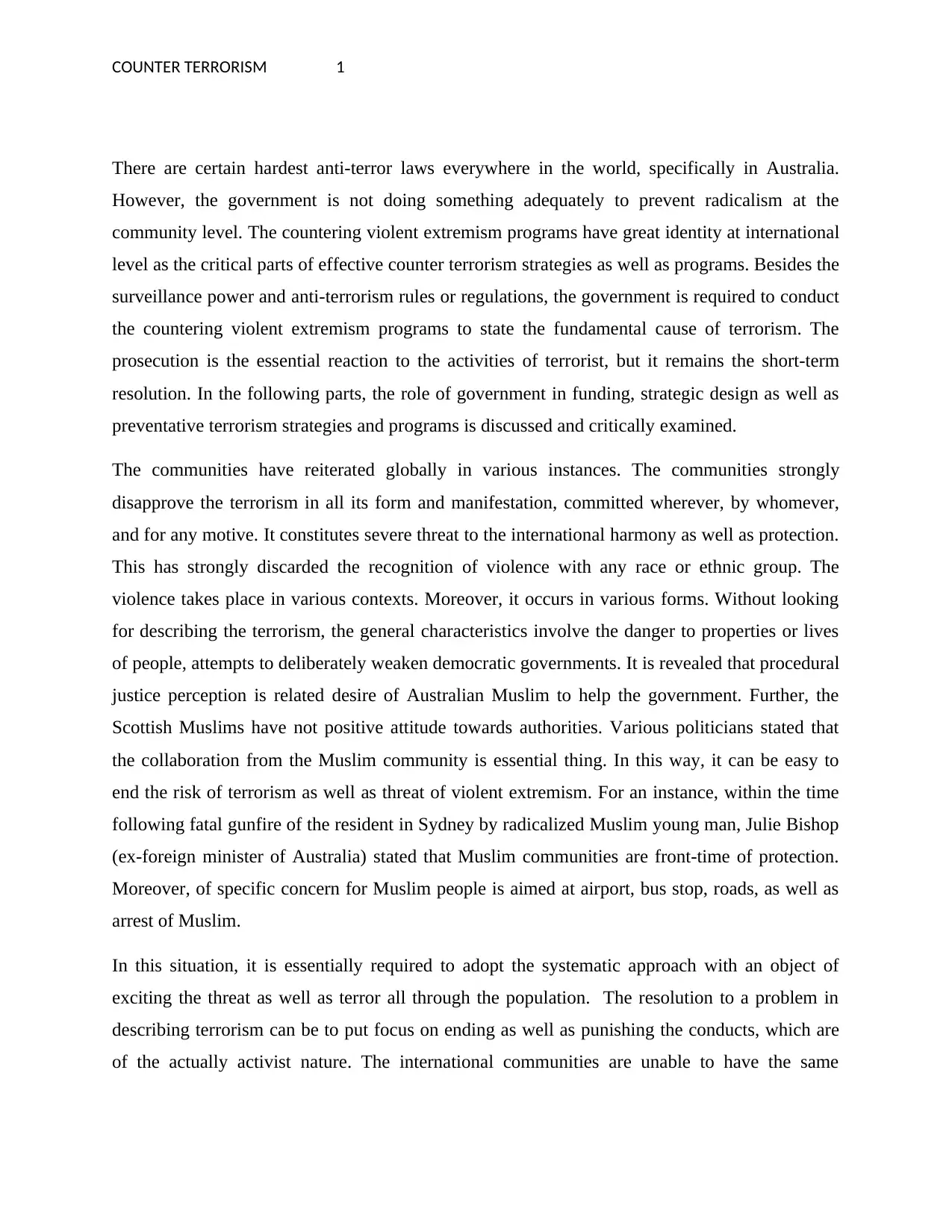
COUNTER TERRORISM 1
There are certain hardest anti-terror laws everywhere in the world, specifically in Australia.
However, the government is not doing something adequately to prevent radicalism at the
community level. The countering violent extremism programs have great identity at international
level as the critical parts of effective counter terrorism strategies as well as programs. Besides the
surveillance power and anti-terrorism rules or regulations, the government is required to conduct
the countering violent extremism programs to state the fundamental cause of terrorism. The
prosecution is the essential reaction to the activities of terrorist, but it remains the short-term
resolution. In the following parts, the role of government in funding, strategic design as well as
preventative terrorism strategies and programs is discussed and critically examined.
The communities have reiterated globally in various instances. The communities strongly
disapprove the terrorism in all its form and manifestation, committed wherever, by whomever,
and for any motive. It constitutes severe threat to the international harmony as well as protection.
This has strongly discarded the recognition of violence with any race or ethnic group. The
violence takes place in various contexts. Moreover, it occurs in various forms. Without looking
for describing the terrorism, the general characteristics involve the danger to properties or lives
of people, attempts to deliberately weaken democratic governments. It is revealed that procedural
justice perception is related desire of Australian Muslim to help the government. Further, the
Scottish Muslims have not positive attitude towards authorities. Various politicians stated that
the collaboration from the Muslim community is essential thing. In this way, it can be easy to
end the risk of terrorism as well as threat of violent extremism. For an instance, within the time
following fatal gunfire of the resident in Sydney by radicalized Muslim young man, Julie Bishop
(ex-foreign minister of Australia) stated that Muslim communities are front-time of protection.
Moreover, of specific concern for Muslim people is aimed at airport, bus stop, roads, as well as
arrest of Muslim.
In this situation, it is essentially required to adopt the systematic approach with an object of
exciting the threat as well as terror all through the population. The resolution to a problem in
describing terrorism can be to put focus on ending as well as punishing the conducts, which are
of the actually activist nature. The international communities are unable to have the same
There are certain hardest anti-terror laws everywhere in the world, specifically in Australia.
However, the government is not doing something adequately to prevent radicalism at the
community level. The countering violent extremism programs have great identity at international
level as the critical parts of effective counter terrorism strategies as well as programs. Besides the
surveillance power and anti-terrorism rules or regulations, the government is required to conduct
the countering violent extremism programs to state the fundamental cause of terrorism. The
prosecution is the essential reaction to the activities of terrorist, but it remains the short-term
resolution. In the following parts, the role of government in funding, strategic design as well as
preventative terrorism strategies and programs is discussed and critically examined.
The communities have reiterated globally in various instances. The communities strongly
disapprove the terrorism in all its form and manifestation, committed wherever, by whomever,
and for any motive. It constitutes severe threat to the international harmony as well as protection.
This has strongly discarded the recognition of violence with any race or ethnic group. The
violence takes place in various contexts. Moreover, it occurs in various forms. Without looking
for describing the terrorism, the general characteristics involve the danger to properties or lives
of people, attempts to deliberately weaken democratic governments. It is revealed that procedural
justice perception is related desire of Australian Muslim to help the government. Further, the
Scottish Muslims have not positive attitude towards authorities. Various politicians stated that
the collaboration from the Muslim community is essential thing. In this way, it can be easy to
end the risk of terrorism as well as threat of violent extremism. For an instance, within the time
following fatal gunfire of the resident in Sydney by radicalized Muslim young man, Julie Bishop
(ex-foreign minister of Australia) stated that Muslim communities are front-time of protection.
Moreover, of specific concern for Muslim people is aimed at airport, bus stop, roads, as well as
arrest of Muslim.
In this situation, it is essentially required to adopt the systematic approach with an object of
exciting the threat as well as terror all through the population. The resolution to a problem in
describing terrorism can be to put focus on ending as well as punishing the conducts, which are
of the actually activist nature. The international communities are unable to have the same
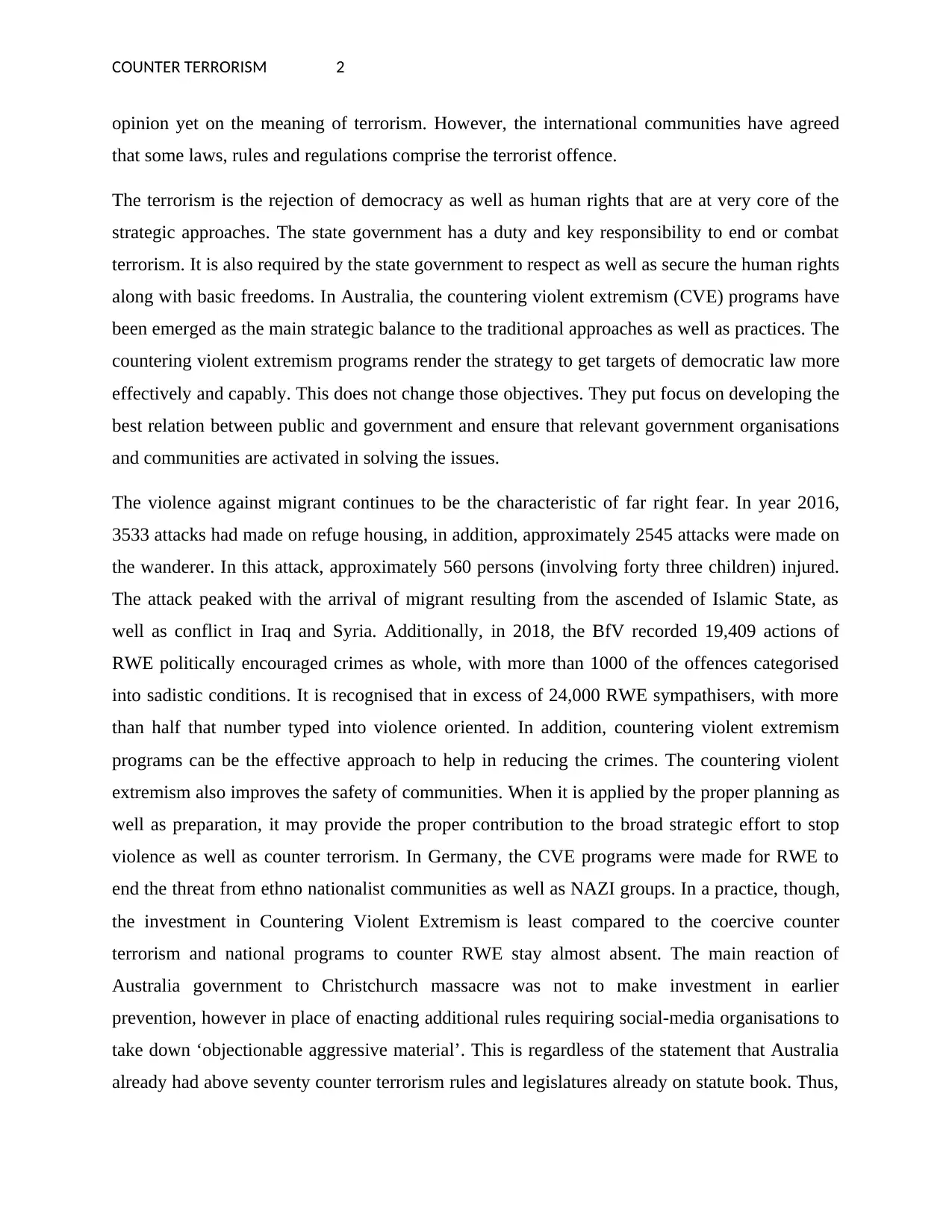
COUNTER TERRORISM 2
opinion yet on the meaning of terrorism. However, the international communities have agreed
that some laws, rules and regulations comprise the terrorist offence.
The terrorism is the rejection of democracy as well as human rights that are at very core of the
strategic approaches. The state government has a duty and key responsibility to end or combat
terrorism. It is also required by the state government to respect as well as secure the human rights
along with basic freedoms. In Australia, the countering violent extremism (CVE) programs have
been emerged as the main strategic balance to the traditional approaches as well as practices. The
countering violent extremism programs render the strategy to get targets of democratic law more
effectively and capably. This does not change those objectives. They put focus on developing the
best relation between public and government and ensure that relevant government organisations
and communities are activated in solving the issues.
The violence against migrant continues to be the characteristic of far right fear. In year 2016,
3533 attacks had made on refuge housing, in addition, approximately 2545 attacks were made on
the wanderer. In this attack, approximately 560 persons (involving forty three children) injured.
The attack peaked with the arrival of migrant resulting from the ascended of Islamic State, as
well as conflict in Iraq and Syria. Additionally, in 2018, the BfV recorded 19,409 actions of
RWE politically encouraged crimes as whole, with more than 1000 of the offences categorised
into sadistic conditions. It is recognised that in excess of 24,000 RWE sympathisers, with more
than half that number typed into violence oriented. In addition, countering violent extremism
programs can be the effective approach to help in reducing the crimes. The countering violent
extremism also improves the safety of communities. When it is applied by the proper planning as
well as preparation, it may provide the proper contribution to the broad strategic effort to stop
violence as well as counter terrorism. In Germany, the CVE programs were made for RWE to
end the threat from ethno nationalist communities as well as NAZI groups. In a practice, though,
the investment in Countering Violent Extremism is least compared to the coercive counter
terrorism and national programs to counter RWE stay almost absent. The main reaction of
Australia government to Christchurch massacre was not to make investment in earlier
prevention, however in place of enacting additional rules requiring social-media organisations to
take down ‘objectionable aggressive material’. This is regardless of the statement that Australia
already had above seventy counter terrorism rules and legislatures already on statute book. Thus,
opinion yet on the meaning of terrorism. However, the international communities have agreed
that some laws, rules and regulations comprise the terrorist offence.
The terrorism is the rejection of democracy as well as human rights that are at very core of the
strategic approaches. The state government has a duty and key responsibility to end or combat
terrorism. It is also required by the state government to respect as well as secure the human rights
along with basic freedoms. In Australia, the countering violent extremism (CVE) programs have
been emerged as the main strategic balance to the traditional approaches as well as practices. The
countering violent extremism programs render the strategy to get targets of democratic law more
effectively and capably. This does not change those objectives. They put focus on developing the
best relation between public and government and ensure that relevant government organisations
and communities are activated in solving the issues.
The violence against migrant continues to be the characteristic of far right fear. In year 2016,
3533 attacks had made on refuge housing, in addition, approximately 2545 attacks were made on
the wanderer. In this attack, approximately 560 persons (involving forty three children) injured.
The attack peaked with the arrival of migrant resulting from the ascended of Islamic State, as
well as conflict in Iraq and Syria. Additionally, in 2018, the BfV recorded 19,409 actions of
RWE politically encouraged crimes as whole, with more than 1000 of the offences categorised
into sadistic conditions. It is recognised that in excess of 24,000 RWE sympathisers, with more
than half that number typed into violence oriented. In addition, countering violent extremism
programs can be the effective approach to help in reducing the crimes. The countering violent
extremism also improves the safety of communities. When it is applied by the proper planning as
well as preparation, it may provide the proper contribution to the broad strategic effort to stop
violence as well as counter terrorism. In Germany, the CVE programs were made for RWE to
end the threat from ethno nationalist communities as well as NAZI groups. In a practice, though,
the investment in Countering Violent Extremism is least compared to the coercive counter
terrorism and national programs to counter RWE stay almost absent. The main reaction of
Australia government to Christchurch massacre was not to make investment in earlier
prevention, however in place of enacting additional rules requiring social-media organisations to
take down ‘objectionable aggressive material’. This is regardless of the statement that Australia
already had above seventy counter terrorism rules and legislatures already on statute book. Thus,
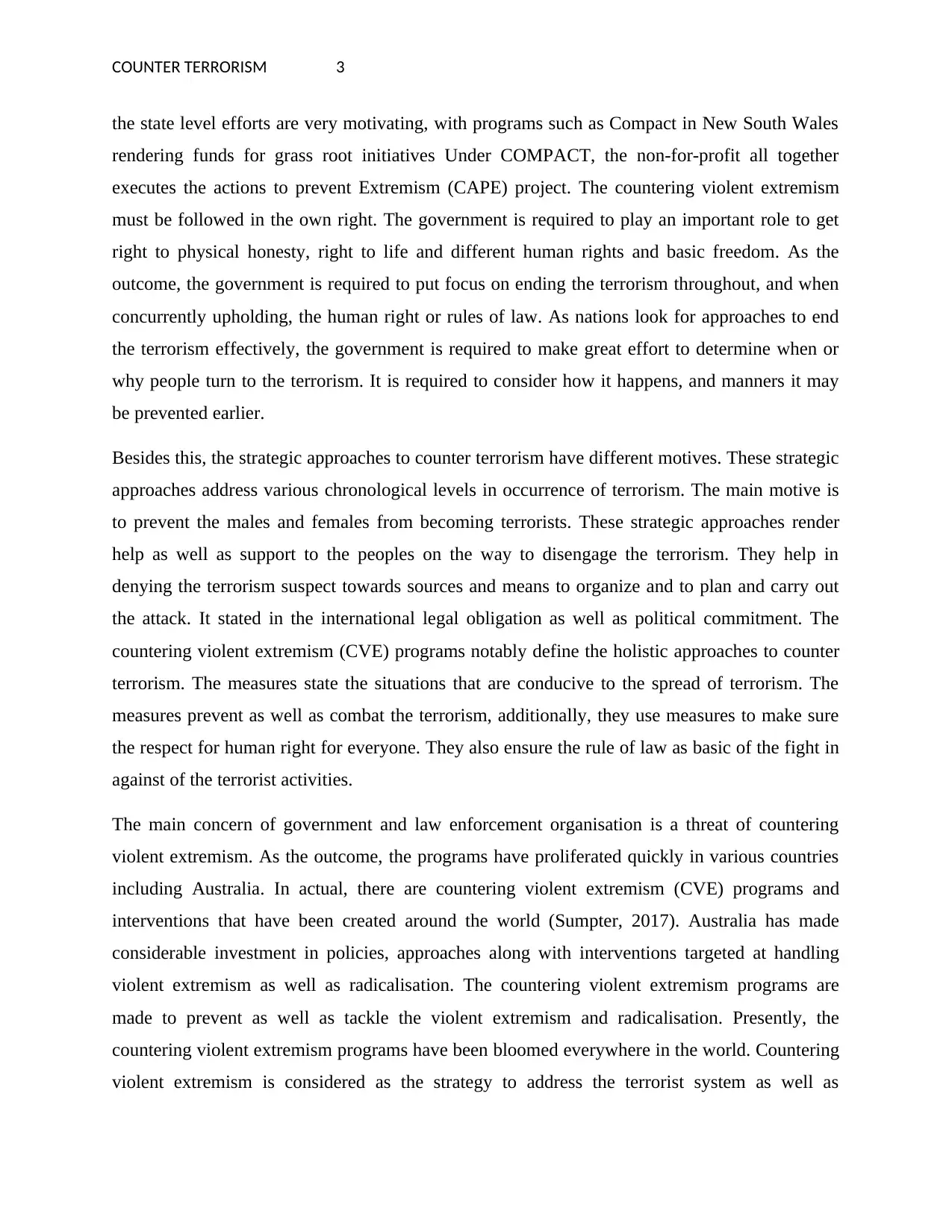
COUNTER TERRORISM 3
the state level efforts are very motivating, with programs such as Compact in New South Wales
rendering funds for grass root initiatives Under COMPACT, the non-for-profit all together
executes the actions to prevent Extremism (CAPE) project. The countering violent extremism
must be followed in the own right. The government is required to play an important role to get
right to physical honesty, right to life and different human rights and basic freedom. As the
outcome, the government is required to put focus on ending the terrorism throughout, and when
concurrently upholding, the human right or rules of law. As nations look for approaches to end
the terrorism effectively, the government is required to make great effort to determine when or
why people turn to the terrorism. It is required to consider how it happens, and manners it may
be prevented earlier.
Besides this, the strategic approaches to counter terrorism have different motives. These strategic
approaches address various chronological levels in occurrence of terrorism. The main motive is
to prevent the males and females from becoming terrorists. These strategic approaches render
help as well as support to the peoples on the way to disengage the terrorism. They help in
denying the terrorism suspect towards sources and means to organize and to plan and carry out
the attack. It stated in the international legal obligation as well as political commitment. The
countering violent extremism (CVE) programs notably define the holistic approaches to counter
terrorism. The measures state the situations that are conducive to the spread of terrorism. The
measures prevent as well as combat the terrorism, additionally, they use measures to make sure
the respect for human right for everyone. They also ensure the rule of law as basic of the fight in
against of the terrorist activities.
The main concern of government and law enforcement organisation is a threat of countering
violent extremism. As the outcome, the programs have proliferated quickly in various countries
including Australia. In actual, there are countering violent extremism (CVE) programs and
interventions that have been created around the world (Sumpter, 2017). Australia has made
considerable investment in policies, approaches along with interventions targeted at handling
violent extremism as well as radicalisation. The countering violent extremism programs are
made to prevent as well as tackle the violent extremism and radicalisation. Presently, the
countering violent extremism programs have been bloomed everywhere in the world. Countering
violent extremism is considered as the strategy to address the terrorist system as well as
the state level efforts are very motivating, with programs such as Compact in New South Wales
rendering funds for grass root initiatives Under COMPACT, the non-for-profit all together
executes the actions to prevent Extremism (CAPE) project. The countering violent extremism
must be followed in the own right. The government is required to play an important role to get
right to physical honesty, right to life and different human rights and basic freedom. As the
outcome, the government is required to put focus on ending the terrorism throughout, and when
concurrently upholding, the human right or rules of law. As nations look for approaches to end
the terrorism effectively, the government is required to make great effort to determine when or
why people turn to the terrorism. It is required to consider how it happens, and manners it may
be prevented earlier.
Besides this, the strategic approaches to counter terrorism have different motives. These strategic
approaches address various chronological levels in occurrence of terrorism. The main motive is
to prevent the males and females from becoming terrorists. These strategic approaches render
help as well as support to the peoples on the way to disengage the terrorism. They help in
denying the terrorism suspect towards sources and means to organize and to plan and carry out
the attack. It stated in the international legal obligation as well as political commitment. The
countering violent extremism (CVE) programs notably define the holistic approaches to counter
terrorism. The measures state the situations that are conducive to the spread of terrorism. The
measures prevent as well as combat the terrorism, additionally, they use measures to make sure
the respect for human right for everyone. They also ensure the rule of law as basic of the fight in
against of the terrorist activities.
The main concern of government and law enforcement organisation is a threat of countering
violent extremism. As the outcome, the programs have proliferated quickly in various countries
including Australia. In actual, there are countering violent extremism (CVE) programs and
interventions that have been created around the world (Sumpter, 2017). Australia has made
considerable investment in policies, approaches along with interventions targeted at handling
violent extremism as well as radicalisation. The countering violent extremism programs are
made to prevent as well as tackle the violent extremism and radicalisation. Presently, the
countering violent extremism programs have been bloomed everywhere in the world. Countering
violent extremism is considered as the strategy to address the terrorist system as well as
Secure Best Marks with AI Grader
Need help grading? Try our AI Grader for instant feedback on your assignments.
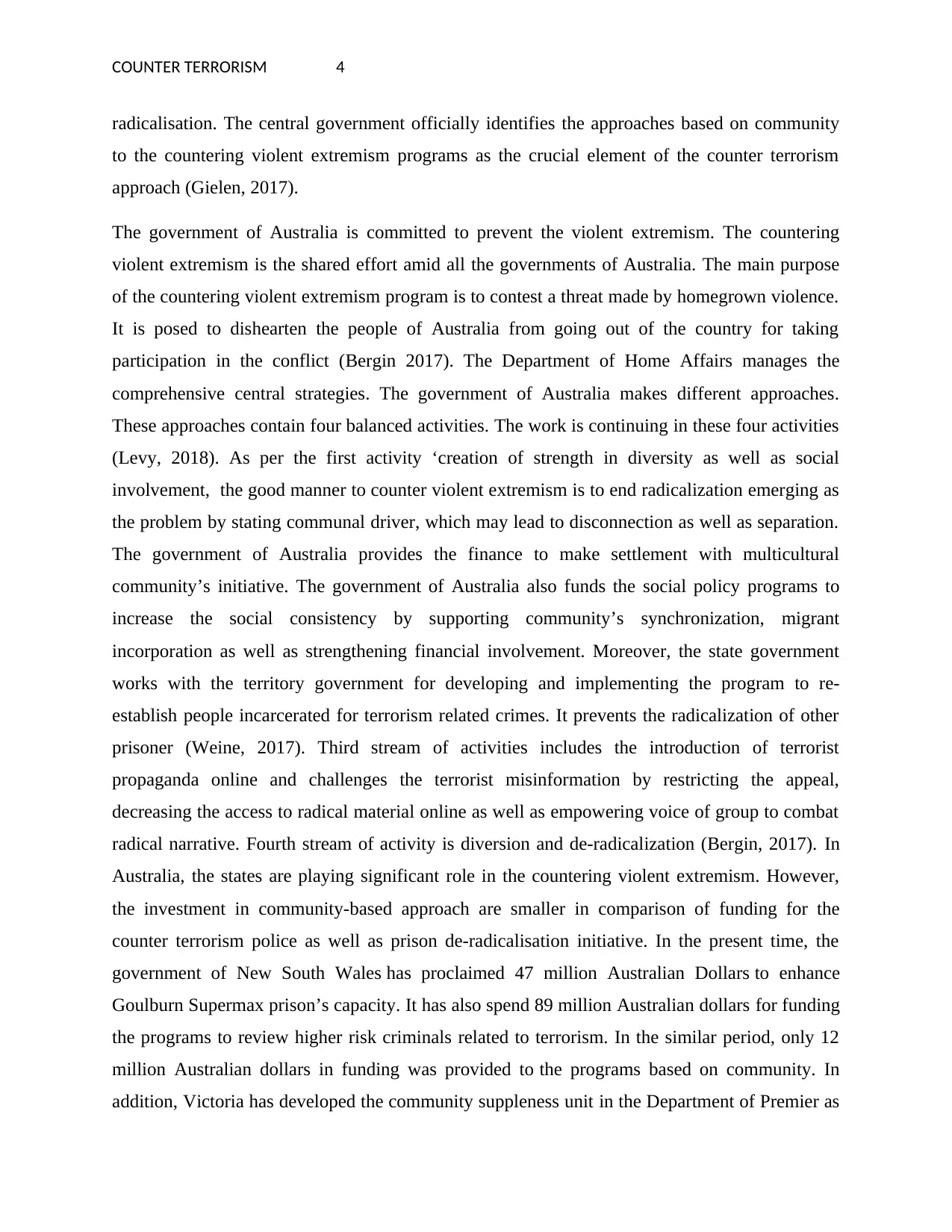
COUNTER TERRORISM 4
radicalisation. The central government officially identifies the approaches based on community
to the countering violent extremism programs as the crucial element of the counter terrorism
approach (Gielen, 2017).
The government of Australia is committed to prevent the violent extremism. The countering
violent extremism is the shared effort amid all the governments of Australia. The main purpose
of the countering violent extremism program is to contest a threat made by homegrown violence.
It is posed to dishearten the people of Australia from going out of the country for taking
participation in the conflict (Bergin 2017). The Department of Home Affairs manages the
comprehensive central strategies. The government of Australia makes different approaches.
These approaches contain four balanced activities. The work is continuing in these four activities
(Levy, 2018). As per the first activity ‘creation of strength in diversity as well as social
involvement, the good manner to counter violent extremism is to end radicalization emerging as
the problem by stating communal driver, which may lead to disconnection as well as separation.
The government of Australia provides the finance to make settlement with multicultural
community’s initiative. The government of Australia also funds the social policy programs to
increase the social consistency by supporting community’s synchronization, migrant
incorporation as well as strengthening financial involvement. Moreover, the state government
works with the territory government for developing and implementing the program to re-
establish people incarcerated for terrorism related crimes. It prevents the radicalization of other
prisoner (Weine, 2017). Third stream of activities includes the introduction of terrorist
propaganda online and challenges the terrorist misinformation by restricting the appeal,
decreasing the access to radical material online as well as empowering voice of group to combat
radical narrative. Fourth stream of activity is diversion and de-radicalization (Bergin, 2017). In
Australia, the states are playing significant role in the countering violent extremism. However,
the investment in community-based approach are smaller in comparison of funding for the
counter terrorism police as well as prison de-radicalisation initiative. In the present time, the
government of New South Wales has proclaimed 47 million Australian Dollars to enhance
Goulburn Supermax prison’s capacity. It has also spend 89 million Australian dollars for funding
the programs to review higher risk criminals related to terrorism. In the similar period, only 12
million Australian dollars in funding was provided to the programs based on community. In
addition, Victoria has developed the community suppleness unit in the Department of Premier as
radicalisation. The central government officially identifies the approaches based on community
to the countering violent extremism programs as the crucial element of the counter terrorism
approach (Gielen, 2017).
The government of Australia is committed to prevent the violent extremism. The countering
violent extremism is the shared effort amid all the governments of Australia. The main purpose
of the countering violent extremism program is to contest a threat made by homegrown violence.
It is posed to dishearten the people of Australia from going out of the country for taking
participation in the conflict (Bergin 2017). The Department of Home Affairs manages the
comprehensive central strategies. The government of Australia makes different approaches.
These approaches contain four balanced activities. The work is continuing in these four activities
(Levy, 2018). As per the first activity ‘creation of strength in diversity as well as social
involvement, the good manner to counter violent extremism is to end radicalization emerging as
the problem by stating communal driver, which may lead to disconnection as well as separation.
The government of Australia provides the finance to make settlement with multicultural
community’s initiative. The government of Australia also funds the social policy programs to
increase the social consistency by supporting community’s synchronization, migrant
incorporation as well as strengthening financial involvement. Moreover, the state government
works with the territory government for developing and implementing the program to re-
establish people incarcerated for terrorism related crimes. It prevents the radicalization of other
prisoner (Weine, 2017). Third stream of activities includes the introduction of terrorist
propaganda online and challenges the terrorist misinformation by restricting the appeal,
decreasing the access to radical material online as well as empowering voice of group to combat
radical narrative. Fourth stream of activity is diversion and de-radicalization (Bergin, 2017). In
Australia, the states are playing significant role in the countering violent extremism. However,
the investment in community-based approach are smaller in comparison of funding for the
counter terrorism police as well as prison de-radicalisation initiative. In the present time, the
government of New South Wales has proclaimed 47 million Australian Dollars to enhance
Goulburn Supermax prison’s capacity. It has also spend 89 million Australian dollars for funding
the programs to review higher risk criminals related to terrorism. In the similar period, only 12
million Australian dollars in funding was provided to the programs based on community. In
addition, Victoria has developed the community suppleness unit in the Department of Premier as
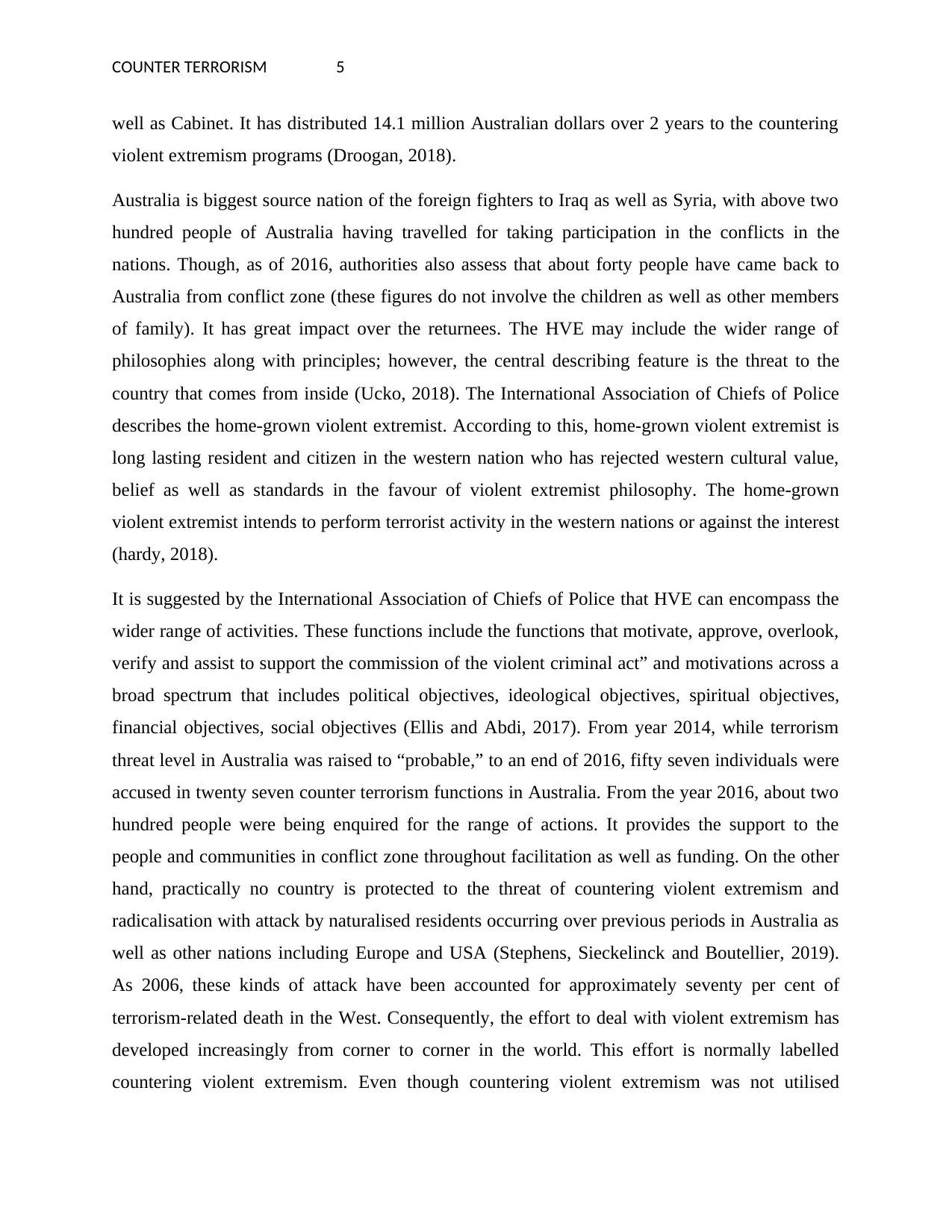
COUNTER TERRORISM 5
well as Cabinet. It has distributed 14.1 million Australian dollars over 2 years to the countering
violent extremism programs (Droogan, 2018).
Australia is biggest source nation of the foreign fighters to Iraq as well as Syria, with above two
hundred people of Australia having travelled for taking participation in the conflicts in the
nations. Though, as of 2016, authorities also assess that about forty people have came back to
Australia from conflict zone (these figures do not involve the children as well as other members
of family). It has great impact over the returnees. The HVE may include the wider range of
philosophies along with principles; however, the central describing feature is the threat to the
country that comes from inside (Ucko, 2018). The International Association of Chiefs of Police
describes the home-grown violent extremist. According to this, home-grown violent extremist is
long lasting resident and citizen in the western nation who has rejected western cultural value,
belief as well as standards in the favour of violent extremist philosophy. The home-grown
violent extremist intends to perform terrorist activity in the western nations or against the interest
(hardy, 2018).
It is suggested by the International Association of Chiefs of Police that HVE can encompass the
wider range of activities. These functions include the functions that motivate, approve, overlook,
verify and assist to support the commission of the violent criminal act” and motivations across a
broad spectrum that includes political objectives, ideological objectives, spiritual objectives,
financial objectives, social objectives (Ellis and Abdi, 2017). From year 2014, while terrorism
threat level in Australia was raised to “probable,” to an end of 2016, fifty seven individuals were
accused in twenty seven counter terrorism functions in Australia. From the year 2016, about two
hundred people were being enquired for the range of actions. It provides the support to the
people and communities in conflict zone throughout facilitation as well as funding. On the other
hand, practically no country is protected to the threat of countering violent extremism and
radicalisation with attack by naturalised residents occurring over previous periods in Australia as
well as other nations including Europe and USA (Stephens, Sieckelinck and Boutellier, 2019).
As 2006, these kinds of attack have been accounted for approximately seventy per cent of
terrorism-related death in the West. Consequently, the effort to deal with violent extremism has
developed increasingly from corner to corner in the world. This effort is normally labelled
countering violent extremism. Even though countering violent extremism was not utilised
well as Cabinet. It has distributed 14.1 million Australian dollars over 2 years to the countering
violent extremism programs (Droogan, 2018).
Australia is biggest source nation of the foreign fighters to Iraq as well as Syria, with above two
hundred people of Australia having travelled for taking participation in the conflicts in the
nations. Though, as of 2016, authorities also assess that about forty people have came back to
Australia from conflict zone (these figures do not involve the children as well as other members
of family). It has great impact over the returnees. The HVE may include the wider range of
philosophies along with principles; however, the central describing feature is the threat to the
country that comes from inside (Ucko, 2018). The International Association of Chiefs of Police
describes the home-grown violent extremist. According to this, home-grown violent extremist is
long lasting resident and citizen in the western nation who has rejected western cultural value,
belief as well as standards in the favour of violent extremist philosophy. The home-grown
violent extremist intends to perform terrorist activity in the western nations or against the interest
(hardy, 2018).
It is suggested by the International Association of Chiefs of Police that HVE can encompass the
wider range of activities. These functions include the functions that motivate, approve, overlook,
verify and assist to support the commission of the violent criminal act” and motivations across a
broad spectrum that includes political objectives, ideological objectives, spiritual objectives,
financial objectives, social objectives (Ellis and Abdi, 2017). From year 2014, while terrorism
threat level in Australia was raised to “probable,” to an end of 2016, fifty seven individuals were
accused in twenty seven counter terrorism functions in Australia. From the year 2016, about two
hundred people were being enquired for the range of actions. It provides the support to the
people and communities in conflict zone throughout facilitation as well as funding. On the other
hand, practically no country is protected to the threat of countering violent extremism and
radicalisation with attack by naturalised residents occurring over previous periods in Australia as
well as other nations including Europe and USA (Stephens, Sieckelinck and Boutellier, 2019).
As 2006, these kinds of attack have been accounted for approximately seventy per cent of
terrorism-related death in the West. Consequently, the effort to deal with violent extremism has
developed increasingly from corner to corner in the world. This effort is normally labelled
countering violent extremism. Even though countering violent extremism was not utilised
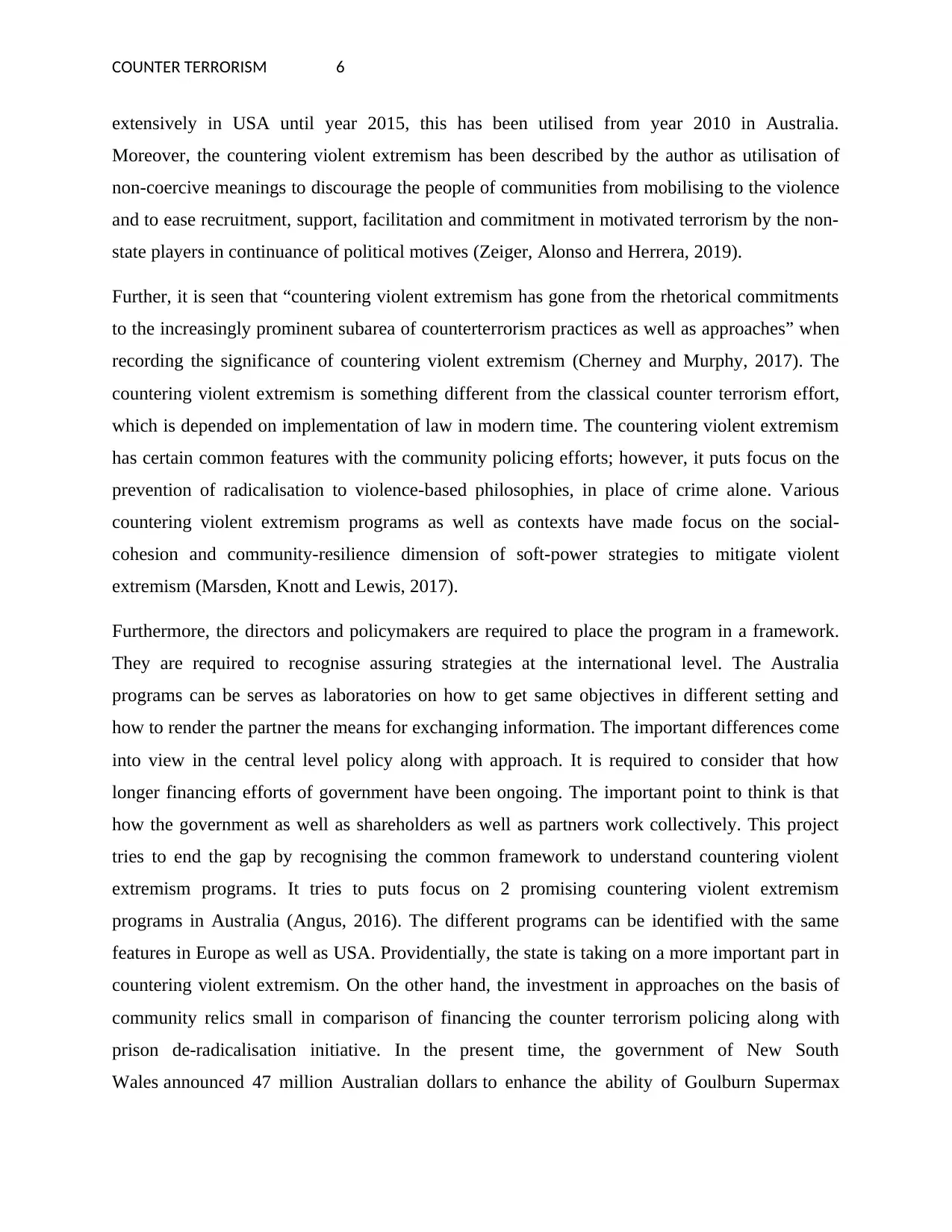
COUNTER TERRORISM 6
extensively in USA until year 2015, this has been utilised from year 2010 in Australia.
Moreover, the countering violent extremism has been described by the author as utilisation of
non-coercive meanings to discourage the people of communities from mobilising to the violence
and to ease recruitment, support, facilitation and commitment in motivated terrorism by the non-
state players in continuance of political motives (Zeiger, Alonso and Herrera, 2019).
Further, it is seen that “countering violent extremism has gone from the rhetorical commitments
to the increasingly prominent subarea of counterterrorism practices as well as approaches” when
recording the significance of countering violent extremism (Cherney and Murphy, 2017). The
countering violent extremism is something different from the classical counter terrorism effort,
which is depended on implementation of law in modern time. The countering violent extremism
has certain common features with the community policing efforts; however, it puts focus on the
prevention of radicalisation to violence-based philosophies, in place of crime alone. Various
countering violent extremism programs as well as contexts have made focus on the social-
cohesion and community-resilience dimension of soft-power strategies to mitigate violent
extremism (Marsden, Knott and Lewis, 2017).
Furthermore, the directors and policymakers are required to place the program in a framework.
They are required to recognise assuring strategies at the international level. The Australia
programs can be serves as laboratories on how to get same objectives in different setting and
how to render the partner the means for exchanging information. The important differences come
into view in the central level policy along with approach. It is required to consider that how
longer financing efforts of government have been ongoing. The important point to think is that
how the government as well as shareholders as well as partners work collectively. This project
tries to end the gap by recognising the common framework to understand countering violent
extremism programs. It tries to puts focus on 2 promising countering violent extremism
programs in Australia (Angus, 2016). The different programs can be identified with the same
features in Europe as well as USA. Providentially, the state is taking on a more important part in
countering violent extremism. On the other hand, the investment in approaches on the basis of
community relics small in comparison of financing the counter terrorism policing along with
prison de-radicalisation initiative. In the present time, the government of New South
Wales announced 47 million Australian dollars to enhance the ability of Goulburn Supermax
extensively in USA until year 2015, this has been utilised from year 2010 in Australia.
Moreover, the countering violent extremism has been described by the author as utilisation of
non-coercive meanings to discourage the people of communities from mobilising to the violence
and to ease recruitment, support, facilitation and commitment in motivated terrorism by the non-
state players in continuance of political motives (Zeiger, Alonso and Herrera, 2019).
Further, it is seen that “countering violent extremism has gone from the rhetorical commitments
to the increasingly prominent subarea of counterterrorism practices as well as approaches” when
recording the significance of countering violent extremism (Cherney and Murphy, 2017). The
countering violent extremism is something different from the classical counter terrorism effort,
which is depended on implementation of law in modern time. The countering violent extremism
has certain common features with the community policing efforts; however, it puts focus on the
prevention of radicalisation to violence-based philosophies, in place of crime alone. Various
countering violent extremism programs as well as contexts have made focus on the social-
cohesion and community-resilience dimension of soft-power strategies to mitigate violent
extremism (Marsden, Knott and Lewis, 2017).
Furthermore, the directors and policymakers are required to place the program in a framework.
They are required to recognise assuring strategies at the international level. The Australia
programs can be serves as laboratories on how to get same objectives in different setting and
how to render the partner the means for exchanging information. The important differences come
into view in the central level policy along with approach. It is required to consider that how
longer financing efforts of government have been ongoing. The important point to think is that
how the government as well as shareholders as well as partners work collectively. This project
tries to end the gap by recognising the common framework to understand countering violent
extremism programs. It tries to puts focus on 2 promising countering violent extremism
programs in Australia (Angus, 2016). The different programs can be identified with the same
features in Europe as well as USA. Providentially, the state is taking on a more important part in
countering violent extremism. On the other hand, the investment in approaches on the basis of
community relics small in comparison of financing the counter terrorism policing along with
prison de-radicalisation initiative. In the present time, the government of New South
Wales announced 47 million Australian dollars to enhance the ability of Goulburn Supermax
Paraphrase This Document
Need a fresh take? Get an instant paraphrase of this document with our AI Paraphraser
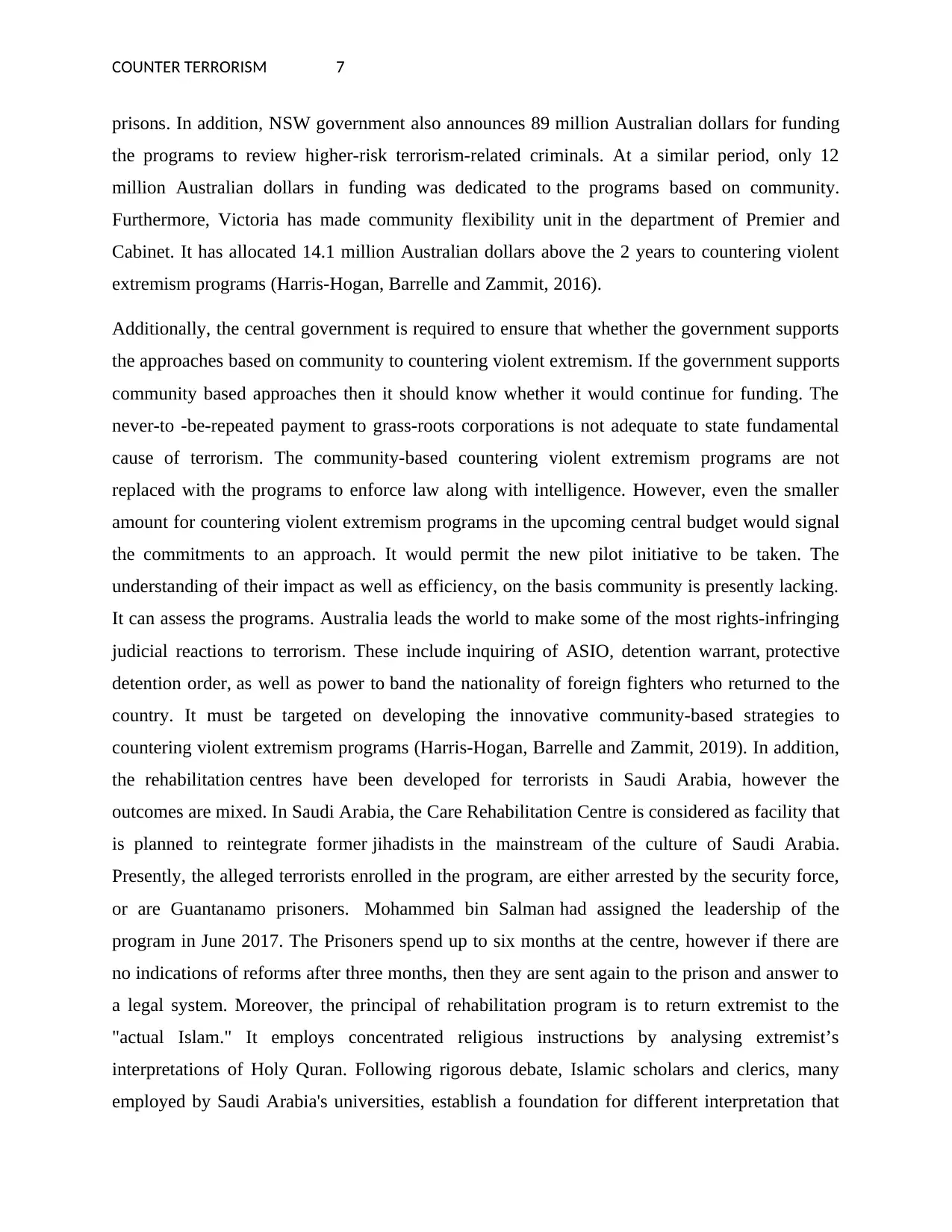
COUNTER TERRORISM 7
prisons. In addition, NSW government also announces 89 million Australian dollars for funding
the programs to review higher-risk terrorism-related criminals. At a similar period, only 12
million Australian dollars in funding was dedicated to the programs based on community.
Furthermore, Victoria has made community flexibility unit in the department of Premier and
Cabinet. It has allocated 14.1 million Australian dollars above the 2 years to countering violent
extremism programs (Harris-Hogan, Barrelle and Zammit, 2016).
Additionally, the central government is required to ensure that whether the government supports
the approaches based on community to countering violent extremism. If the government supports
community based approaches then it should know whether it would continue for funding. The
never-to -be-repeated payment to grass-roots corporations is not adequate to state fundamental
cause of terrorism. The community-based countering violent extremism programs are not
replaced with the programs to enforce law along with intelligence. However, even the smaller
amount for countering violent extremism programs in the upcoming central budget would signal
the commitments to an approach. It would permit the new pilot initiative to be taken. The
understanding of their impact as well as efficiency, on the basis community is presently lacking.
It can assess the programs. Australia leads the world to make some of the most rights-infringing
judicial reactions to terrorism. These include inquiring of ASIO, detention warrant, protective
detention order, as well as power to band the nationality of foreign fighters who returned to the
country. It must be targeted on developing the innovative community-based strategies to
countering violent extremism programs (Harris-Hogan, Barrelle and Zammit, 2019). In addition,
the rehabilitation centres have been developed for terrorists in Saudi Arabia, however the
outcomes are mixed. In Saudi Arabia, the Care Rehabilitation Centre is considered as facility that
is planned to reintegrate former jihadists in the mainstream of the culture of Saudi Arabia.
Presently, the alleged terrorists enrolled in the program, are either arrested by the security force,
or are Guantanamo prisoners. Mohammed bin Salman had assigned the leadership of the
program in June 2017. The Prisoners spend up to six months at the centre, however if there are
no indications of reforms after three months, then they are sent again to the prison and answer to
a legal system. Moreover, the principal of rehabilitation program is to return extremist to the
"actual Islam." It employs concentrated religious instructions by analysing extremist’s
interpretations of Holy Quran. Following rigorous debate, Islamic scholars and clerics, many
employed by Saudi Arabia's universities, establish a foundation for different interpretation that
prisons. In addition, NSW government also announces 89 million Australian dollars for funding
the programs to review higher-risk terrorism-related criminals. At a similar period, only 12
million Australian dollars in funding was dedicated to the programs based on community.
Furthermore, Victoria has made community flexibility unit in the department of Premier and
Cabinet. It has allocated 14.1 million Australian dollars above the 2 years to countering violent
extremism programs (Harris-Hogan, Barrelle and Zammit, 2016).
Additionally, the central government is required to ensure that whether the government supports
the approaches based on community to countering violent extremism. If the government supports
community based approaches then it should know whether it would continue for funding. The
never-to -be-repeated payment to grass-roots corporations is not adequate to state fundamental
cause of terrorism. The community-based countering violent extremism programs are not
replaced with the programs to enforce law along with intelligence. However, even the smaller
amount for countering violent extremism programs in the upcoming central budget would signal
the commitments to an approach. It would permit the new pilot initiative to be taken. The
understanding of their impact as well as efficiency, on the basis community is presently lacking.
It can assess the programs. Australia leads the world to make some of the most rights-infringing
judicial reactions to terrorism. These include inquiring of ASIO, detention warrant, protective
detention order, as well as power to band the nationality of foreign fighters who returned to the
country. It must be targeted on developing the innovative community-based strategies to
countering violent extremism programs (Harris-Hogan, Barrelle and Zammit, 2019). In addition,
the rehabilitation centres have been developed for terrorists in Saudi Arabia, however the
outcomes are mixed. In Saudi Arabia, the Care Rehabilitation Centre is considered as facility that
is planned to reintegrate former jihadists in the mainstream of the culture of Saudi Arabia.
Presently, the alleged terrorists enrolled in the program, are either arrested by the security force,
or are Guantanamo prisoners. Mohammed bin Salman had assigned the leadership of the
program in June 2017. The Prisoners spend up to six months at the centre, however if there are
no indications of reforms after three months, then they are sent again to the prison and answer to
a legal system. Moreover, the principal of rehabilitation program is to return extremist to the
"actual Islam." It employs concentrated religious instructions by analysing extremist’s
interpretations of Holy Quran. Following rigorous debate, Islamic scholars and clerics, many
employed by Saudi Arabia's universities, establish a foundation for different interpretation that
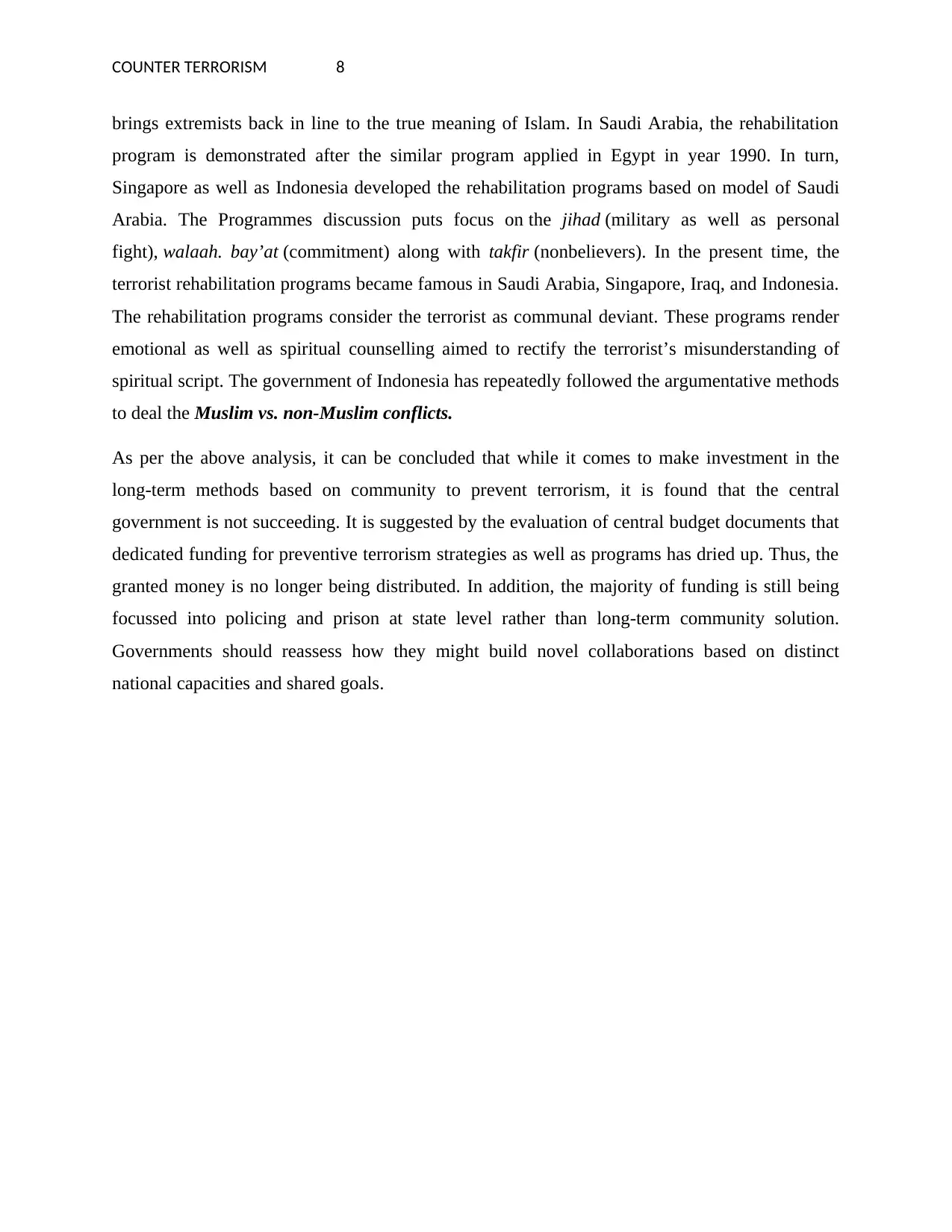
COUNTER TERRORISM 8
brings extremists back in line to the true meaning of Islam. In Saudi Arabia, the rehabilitation
program is demonstrated after the similar program applied in Egypt in year 1990. In turn,
Singapore as well as Indonesia developed the rehabilitation programs based on model of Saudi
Arabia. The Programmes discussion puts focus on the jihad (military as well as personal
fight), walaah. bay’at (commitment) along with takfir (nonbelievers). In the present time, the
terrorist rehabilitation programs became famous in Saudi Arabia, Singapore, Iraq, and Indonesia.
The rehabilitation programs consider the terrorist as communal deviant. These programs render
emotional as well as spiritual counselling aimed to rectify the terrorist’s misunderstanding of
spiritual script. The government of Indonesia has repeatedly followed the argumentative methods
to deal the Muslim vs. non-Muslim conflicts.
As per the above analysis, it can be concluded that while it comes to make investment in the
long-term methods based on community to prevent terrorism, it is found that the central
government is not succeeding. It is suggested by the evaluation of central budget documents that
dedicated funding for preventive terrorism strategies as well as programs has dried up. Thus, the
granted money is no longer being distributed. In addition, the majority of funding is still being
focussed into policing and prison at state level rather than long-term community solution.
Governments should reassess how they might build novel collaborations based on distinct
national capacities and shared goals.
brings extremists back in line to the true meaning of Islam. In Saudi Arabia, the rehabilitation
program is demonstrated after the similar program applied in Egypt in year 1990. In turn,
Singapore as well as Indonesia developed the rehabilitation programs based on model of Saudi
Arabia. The Programmes discussion puts focus on the jihad (military as well as personal
fight), walaah. bay’at (commitment) along with takfir (nonbelievers). In the present time, the
terrorist rehabilitation programs became famous in Saudi Arabia, Singapore, Iraq, and Indonesia.
The rehabilitation programs consider the terrorist as communal deviant. These programs render
emotional as well as spiritual counselling aimed to rectify the terrorist’s misunderstanding of
spiritual script. The government of Indonesia has repeatedly followed the argumentative methods
to deal the Muslim vs. non-Muslim conflicts.
As per the above analysis, it can be concluded that while it comes to make investment in the
long-term methods based on community to prevent terrorism, it is found that the central
government is not succeeding. It is suggested by the evaluation of central budget documents that
dedicated funding for preventive terrorism strategies as well as programs has dried up. Thus, the
granted money is no longer being distributed. In addition, the majority of funding is still being
focussed into policing and prison at state level rather than long-term community solution.
Governments should reassess how they might build novel collaborations based on distinct
national capacities and shared goals.
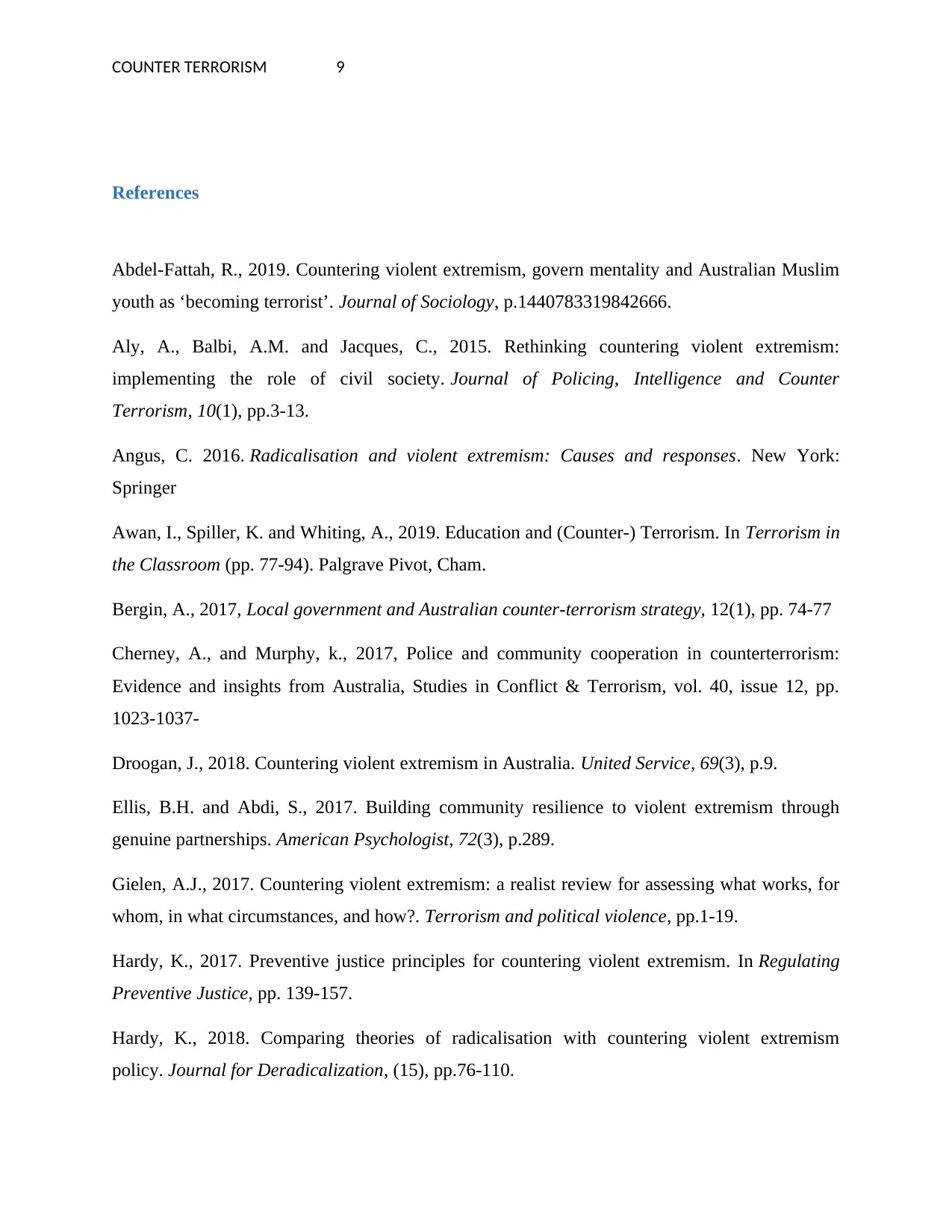
COUNTER TERRORISM 9
References
Abdel-Fattah, R., 2019. Countering violent extremism, govern mentality and Australian Muslim
youth as ‘becoming terrorist’. Journal of Sociology, p.1440783319842666.
Aly, A., Balbi, A.M. and Jacques, C., 2015. Rethinking countering violent extremism:
implementing the role of civil society. Journal of Policing, Intelligence and Counter
Terrorism, 10(1), pp.3-13.
Angus, C. 2016. Radicalisation and violent extremism: Causes and responses. New York:
Springer
Awan, I., Spiller, K. and Whiting, A., 2019. Education and (Counter-) Terrorism. In Terrorism in
the Classroom (pp. 77-94). Palgrave Pivot, Cham.
Bergin, A., 2017, Local government and Australian counter-terrorism strategy, 12(1), pp. 74-77
Cherney, A., and Murphy, k., 2017, Police and community cooperation in counterterrorism:
Evidence and insights from Australia, Studies in Conflict & Terrorism, vol. 40, issue 12, pp.
1023-1037-
Droogan, J., 2018. Countering violent extremism in Australia. United Service, 69(3), p.9.
Ellis, B.H. and Abdi, S., 2017. Building community resilience to violent extremism through
genuine partnerships. American Psychologist, 72(3), p.289.
Gielen, A.J., 2017. Countering violent extremism: a realist review for assessing what works, for
whom, in what circumstances, and how?. Terrorism and political violence, pp.1-19.
Hardy, K., 2017. Preventive justice principles for countering violent extremism. In Regulating
Preventive Justice, pp. 139-157.
Hardy, K., 2018. Comparing theories of radicalisation with countering violent extremism
policy. Journal for Deradicalization, (15), pp.76-110.
References
Abdel-Fattah, R., 2019. Countering violent extremism, govern mentality and Australian Muslim
youth as ‘becoming terrorist’. Journal of Sociology, p.1440783319842666.
Aly, A., Balbi, A.M. and Jacques, C., 2015. Rethinking countering violent extremism:
implementing the role of civil society. Journal of Policing, Intelligence and Counter
Terrorism, 10(1), pp.3-13.
Angus, C. 2016. Radicalisation and violent extremism: Causes and responses. New York:
Springer
Awan, I., Spiller, K. and Whiting, A., 2019. Education and (Counter-) Terrorism. In Terrorism in
the Classroom (pp. 77-94). Palgrave Pivot, Cham.
Bergin, A., 2017, Local government and Australian counter-terrorism strategy, 12(1), pp. 74-77
Cherney, A., and Murphy, k., 2017, Police and community cooperation in counterterrorism:
Evidence and insights from Australia, Studies in Conflict & Terrorism, vol. 40, issue 12, pp.
1023-1037-
Droogan, J., 2018. Countering violent extremism in Australia. United Service, 69(3), p.9.
Ellis, B.H. and Abdi, S., 2017. Building community resilience to violent extremism through
genuine partnerships. American Psychologist, 72(3), p.289.
Gielen, A.J., 2017. Countering violent extremism: a realist review for assessing what works, for
whom, in what circumstances, and how?. Terrorism and political violence, pp.1-19.
Hardy, K., 2017. Preventive justice principles for countering violent extremism. In Regulating
Preventive Justice, pp. 139-157.
Hardy, K., 2018. Comparing theories of radicalisation with countering violent extremism
policy. Journal for Deradicalization, (15), pp.76-110.
Secure Best Marks with AI Grader
Need help grading? Try our AI Grader for instant feedback on your assignments.
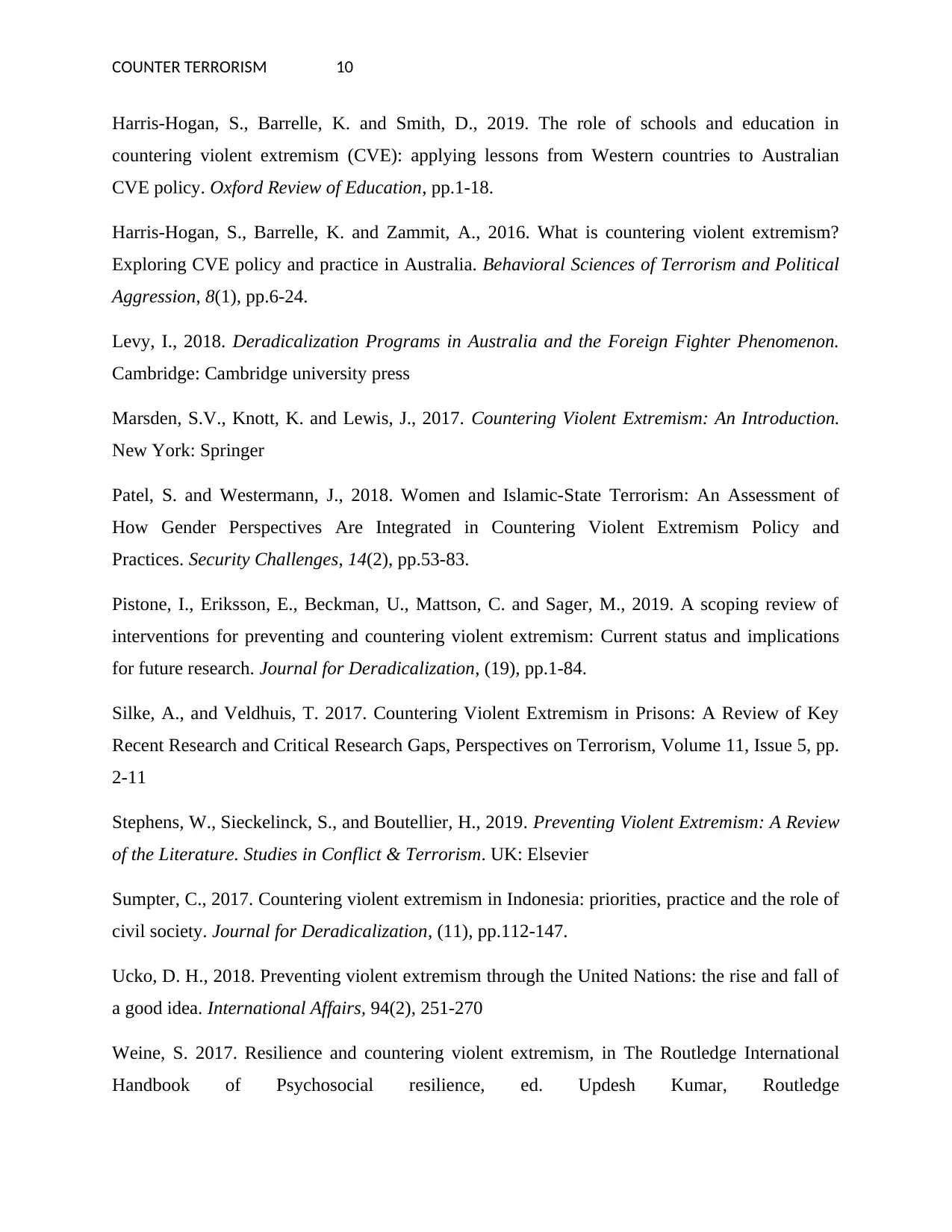
COUNTER TERRORISM 10
Harris-Hogan, S., Barrelle, K. and Smith, D., 2019. The role of schools and education in
countering violent extremism (CVE): applying lessons from Western countries to Australian
CVE policy. Oxford Review of Education, pp.1-18.
Harris-Hogan, S., Barrelle, K. and Zammit, A., 2016. What is countering violent extremism?
Exploring CVE policy and practice in Australia. Behavioral Sciences of Terrorism and Political
Aggression, 8(1), pp.6-24.
Levy, I., 2018. Deradicalization Programs in Australia and the Foreign Fighter Phenomenon.
Cambridge: Cambridge university press
Marsden, S.V., Knott, K. and Lewis, J., 2017. Countering Violent Extremism: An Introduction.
New York: Springer
Patel, S. and Westermann, J., 2018. Women and Islamic-State Terrorism: An Assessment of
How Gender Perspectives Are Integrated in Countering Violent Extremism Policy and
Practices. Security Challenges, 14(2), pp.53-83.
Pistone, I., Eriksson, E., Beckman, U., Mattson, C. and Sager, M., 2019. A scoping review of
interventions for preventing and countering violent extremism: Current status and implications
for future research. Journal for Deradicalization, (19), pp.1-84.
Silke, A., and Veldhuis, T. 2017. Countering Violent Extremism in Prisons: A Review of Key
Recent Research and Critical Research Gaps, Perspectives on Terrorism, Volume 11, Issue 5, pp.
2-11
Stephens, W., Sieckelinck, S., and Boutellier, H., 2019. Preventing Violent Extremism: A Review
of the Literature. Studies in Conflict & Terrorism. UK: Elsevier
Sumpter, C., 2017. Countering violent extremism in Indonesia: priorities, practice and the role of
civil society. Journal for Deradicalization, (11), pp.112-147.
Ucko, D. H., 2018. Preventing violent extremism through the United Nations: the rise and fall of
a good idea. International Affairs, 94(2), 251-270
Weine, S. 2017. Resilience and countering violent extremism, in The Routledge International
Handbook of Psychosocial resilience, ed. Updesh Kumar, Routledge
Harris-Hogan, S., Barrelle, K. and Smith, D., 2019. The role of schools and education in
countering violent extremism (CVE): applying lessons from Western countries to Australian
CVE policy. Oxford Review of Education, pp.1-18.
Harris-Hogan, S., Barrelle, K. and Zammit, A., 2016. What is countering violent extremism?
Exploring CVE policy and practice in Australia. Behavioral Sciences of Terrorism and Political
Aggression, 8(1), pp.6-24.
Levy, I., 2018. Deradicalization Programs in Australia and the Foreign Fighter Phenomenon.
Cambridge: Cambridge university press
Marsden, S.V., Knott, K. and Lewis, J., 2017. Countering Violent Extremism: An Introduction.
New York: Springer
Patel, S. and Westermann, J., 2018. Women and Islamic-State Terrorism: An Assessment of
How Gender Perspectives Are Integrated in Countering Violent Extremism Policy and
Practices. Security Challenges, 14(2), pp.53-83.
Pistone, I., Eriksson, E., Beckman, U., Mattson, C. and Sager, M., 2019. A scoping review of
interventions for preventing and countering violent extremism: Current status and implications
for future research. Journal for Deradicalization, (19), pp.1-84.
Silke, A., and Veldhuis, T. 2017. Countering Violent Extremism in Prisons: A Review of Key
Recent Research and Critical Research Gaps, Perspectives on Terrorism, Volume 11, Issue 5, pp.
2-11
Stephens, W., Sieckelinck, S., and Boutellier, H., 2019. Preventing Violent Extremism: A Review
of the Literature. Studies in Conflict & Terrorism. UK: Elsevier
Sumpter, C., 2017. Countering violent extremism in Indonesia: priorities, practice and the role of
civil society. Journal for Deradicalization, (11), pp.112-147.
Ucko, D. H., 2018. Preventing violent extremism through the United Nations: the rise and fall of
a good idea. International Affairs, 94(2), 251-270
Weine, S. 2017. Resilience and countering violent extremism, in The Routledge International
Handbook of Psychosocial resilience, ed. Updesh Kumar, Routledge
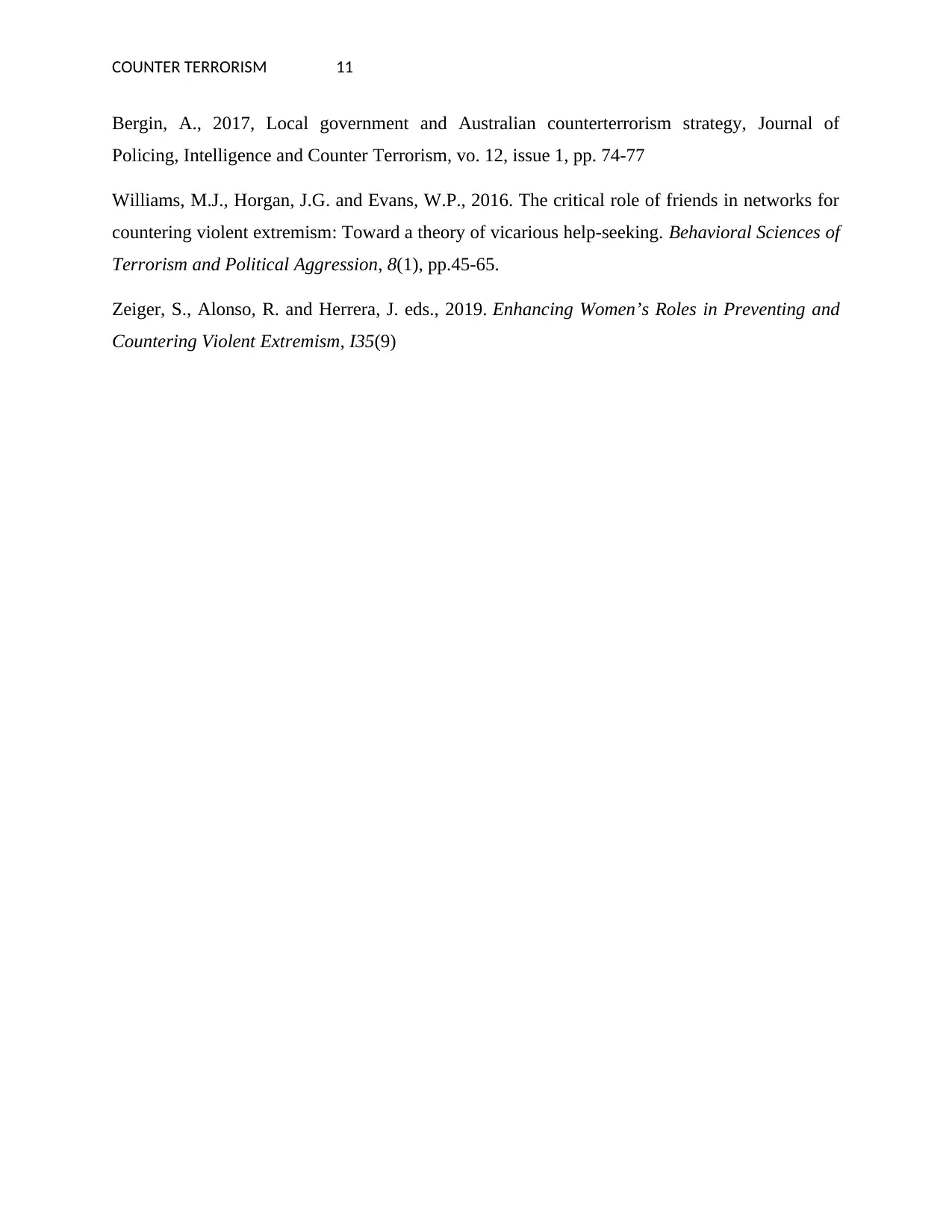
COUNTER TERRORISM 11
Bergin, A., 2017, Local government and Australian counterterrorism strategy, Journal of
Policing, Intelligence and Counter Terrorism, vo. 12, issue 1, pp. 74-77
Williams, M.J., Horgan, J.G. and Evans, W.P., 2016. The critical role of friends in networks for
countering violent extremism: Toward a theory of vicarious help-seeking. Behavioral Sciences of
Terrorism and Political Aggression, 8(1), pp.45-65.
Zeiger, S., Alonso, R. and Herrera, J. eds., 2019. Enhancing Women’s Roles in Preventing and
Countering Violent Extremism, I35(9)
Bergin, A., 2017, Local government and Australian counterterrorism strategy, Journal of
Policing, Intelligence and Counter Terrorism, vo. 12, issue 1, pp. 74-77
Williams, M.J., Horgan, J.G. and Evans, W.P., 2016. The critical role of friends in networks for
countering violent extremism: Toward a theory of vicarious help-seeking. Behavioral Sciences of
Terrorism and Political Aggression, 8(1), pp.45-65.
Zeiger, S., Alonso, R. and Herrera, J. eds., 2019. Enhancing Women’s Roles in Preventing and
Countering Violent Extremism, I35(9)
1 out of 12
Related Documents
Your All-in-One AI-Powered Toolkit for Academic Success.
+13062052269
info@desklib.com
Available 24*7 on WhatsApp / Email
![[object Object]](/_next/static/media/star-bottom.7253800d.svg)
Unlock your academic potential
© 2024 | Zucol Services PVT LTD | All rights reserved.





